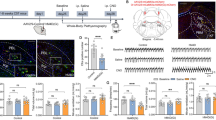Abstract
We assessed the characteristics of muscarinic neural transmission in the vagal inhibitory pathway to the lower esophageal sphincter (LES) of anesthetized opossums. LES relaxation was induced by electrical stimulation of the cervical vagus. Measurements were made of LES relaxation before and after intravenous administration of nicotinic (hexamethonium), serotonergic (5-Meo-DMT), nonselective muscarinic (atropine), and selective muscarinic (pirenzepine-M1 and 4-DAMP-M2) antagonists. The latency of LES relaxamethonium, but was not affected by 4-DAMP or 5-Meo-DMT. Given as concurrent intravenous infusions, hexamethonium, 5-Meo-DMT and 4-DAMP added to pirenzepine or atropine did not significantly increase LES relaxation latency above that caused by pirenzepine or atropine alone. None of the antagonists alone had a significant effect on percent LES relaxation. The combination of pirenzepine or 4-DAMP with hexamethonium and 5-Meo-DMT did not affect percent LES relaxation. The combination of atropine with hexamethonium and 5-Meo-DMT reduced LES relaxation to 18%. The combination of pirenzepine and 4-DAMP with hexamethonium and 5-Meo-DMT, however, had no effect on percent LES relaxation. We conclude that muscarinic participation in vagally induced LES relaxation exhibits two functional receptor subtypes: (1) M1 receptors that determine LES relaxation latency and are antagonized by pirenzepine or atropine, and (2) non-M1, non-M2 receptors, (Mx receptors) that contribute to the magnitude of LES relaxation and are antagonized by atropine, but not by pirenzepine or 4-DAMP.
Similar content being viewed by others
References
Goyal RK, Rattan S: Nature of the vagal inhibitory innervation to the lower esophageal sphincter. J Clin Invest 55:1119–1126, 1975
Gilbert RJ, Rattan S, Goyal RK: Pharmacologic identification, activation and antagonism of the muscarinic receptor subtypes in the lower esophageal sphincter. J Pharmacol Exp Ther 230:284–291, 1984
Goyal RK, Rattan S: Neurohumoral, hormonal and drug receptors for the lower esophageal sphicter. Gastroenterology 74:518–619, 1978
Goyal RK, Cobb B: Motility of the pharynx, esophagus and esophageal sphincter.In Physiology of the Gastrointestinal Tract. LR Johnson (ed). Raven Press, New York, 1981 pp 359–392
Barlow RB, Franks FM, Pearson JDM: A comparison of the affinities of antagonists of acetylecholine receptors in the ileum, bronchial muscle, and iris of the guinea pig. Br J Pharmacol 46:300–314, 1972
Brown DA, Forward A, Marsh S: Antagonist discrimination between ganglionic and ileal muscarinic receptors. Br J Pharmacol 71:362–364, 1980
Hammer R, Berrie CP, Birdsall NJM, Burgen ASV, Hulem EC: Pirenzepine distinguishes between different subclasses of muscarinic receptors. Nature 283:90–92, 1980
Hammer R, Giachetti A: Muscarinic receptor subtypes: M1 and M2. Biochemical and functional characterization. Life Sci 31:2991–2994, 1982
MacIntosh FC: Subtypes of muscarinic receptors: A summary with comments. Trends Pharm Sci (suppl):100–103, 1984
Arndorfer RC, Stef JJ, Dodds WJ, Linehan NH, Hogan WJ: Improved infusion system for intraluminal esophageal manometry. Gastroenterology 73:23–27, 1977
Rattan S, Goyal RK: Evidence of 5-HT participation in the vagal inhibitory pathway to the opossum LES. Am J Physiol 234:273–276, 1978
Watson M, Yamamura Hi, Roeske WR: A unique regulatory profile and regional distribution of [3H]pirenzepine binding in the rate provide evidence for distinct M1 and M muscarinic receptor subtypes. Life Sci 32:3001–3011, 1983
Watson M, Roeske WR, Yamamura HI: [3H]Pirenzepine selectivity identifies a high affinity population of muscarinic cholinergic receptors in the rat cerebral cortex. Life Sci 21:2019–2023, 1982
Raiteri M, Leardi R, Marchi M: Heterogeneity of presynaptic muscarinic receptors regulating neurotransmitter release in the rat brain. J Pharmacol Exp Ther 228:209–214, 1984
Hammer R: Subclasses of muscarinic receptors and pirenzepine: Further experimental evidence. Scand J Gastroenterol 17(suppl 72):59–67, 1982
Birdsall NJM, Burgen ASV, Hulem EC: The binding of agonists to brain muscarinic receptors. Mol Pharmacol 14:723–736, 1978
Author information
Authors and Affiliations
Additional information
This study supported by NIH grants AM07146 and AM25731.
Rights and permissions
About this article
Cite this article
Gilbert, R.J., Dodds, W.J. Subtypes of muscarinic receptors in vagal inhibitory pathway to the lower esophageal sphincter of the opossum. Digest Dis Sci 32, 1130–1135 (1987). https://doi.org/10.1007/BF01300200
Received:
Revised:
Accepted:
Issue Date:
DOI: https://doi.org/10.1007/BF01300200




